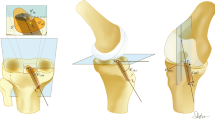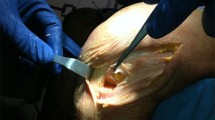Abstract
Purpose
Recently, a computer-assisted navigation system has been used for the quantitative evaluation not only of anterior–posterior (AP) laxity but also rotational laxity of the tibia intraoperatively. The purpose of this study was to investigate how intraoperative AP or rotational laxities measured by the navigation system could correlate with postoperative AP and rotational laxities of the patients.
Methods
125 patients who underwent primary isolated anatomical single- or double-bundle ACL reconstruction or augmentation using multistranded autologous hamstring tendons were included in the study after a minimum of 2-year follow-up. Clinically, absolute value and side-to-side difference (SSD) of AP translation of the tibia were measured by KT-2000 preoperatively and postoperatively. Intraoperative measurement of AP translation of the tibia and total range of tibial rotation of the ACL-injured knee were carried out using the computer-assisted navigation system. We have investigated the relationship between intraoperative measurements using the navigation system and AP laxity measurements using the KT-2000 knee arthrometer as well as rotational laxity measurements using the manual pivot shift test.
Results
There was a positive correlation between the SSD of preoperative AP translation of the tibia measured by KT-2000 arthrometer and the reduction in AP laxity following ACL reconstruction measured by the navigation system. However, we found no significant correlation between the reduction in AP laxity measured by the navigation system and the SSD of AP translation of the tibia measured by the KT-2000 arthrometer at final follow-up. Postoperatively, eight patients had a positive pivot shift test. Using the navigation system pre- and post-ACL reconstruction, these patients could not be identified by high absolute values for AP laxity nor rotational laxity.
Conclusion
Although AP and rotational laxities vary largely among the patients, and AP and rotational stabilization are successfully achieved immediately after ACL reconstruction, intraoperative AP and rotational laxity measured by the navigation system did not influence the postoperative AP and rotational laxities after ACL reconstruction.
Level of evidence
III.






Similar content being viewed by others
References
Adachi N, Ochi M, Uchio Y, Sumen Y (2000) Anterior cruciate ligament augmentation under arthroscopy. A minimum 2-year follow-up in 40 patients. Arch Orthop Trauma Surg 120:128–133
Adachi N, Ochi M, Uchio Y, Iwasa J, Kuriwaka M, Ito Y (2004) Reconstruction of the anterior cruciate ligament. Single- versus double-bundle multistranded hamstring tendons. J Bone Joint Surg Br 86:515–520
Amis AA, Dawkins GP (1991) Functional anatomy of the anterior cruciate ligament. Fibre bundle actions related to ligament replacements and injuries. J Bone Joint Surg Br 73:260–267
Anderson AF (1994) Rating scales. In: Fu FH, Harner CD, Vince KL (eds) Knee surgery. Williams & Wilkins, Baltimore, pp 275–296
Bach BR Jr, Tradonsky S, Bojchuk J, Levy ME, Bush-Joseph CA, Khan NH (1998) Arthroscopy assisted anterior cruciate ligament reconstruction using patellar tendon autograft: five- to nine-year followup evaluation. Am J Sports Med 26:20–29
Balasch H, Schiller M, Friebel H, Hoffmann F (1999) Evaluation of anterior knee joint instability with the Rolimeter. A test in comparison with manual assessment and measuring with the KT-1000 arthrometer. Knee Surg Sports Traumatol Arthrosc 7:204–208
Butler DL, Noyes FR, Grood ES (1980) Ligamentous restraints to anterior-posterior drawer in the human knee. A biomechanical study. J Bone Joint Surg Am 62:259–270
Cheng T, Zhang GY, Zhang XL (2011) Does computer navigation system really improve early clinical outcomes after anterior cruciate ligament reconstruction? A meta-analysis and systematic review of randomized controlled trials. Knee PMID: 21458274
Colombet P, Robinson J, Christel P, Franceschi JP, Djian P (2007) Using navigation to measure rotation kinematics during ACL reconstruction. Clin Orthop Relat Res 454:59–65
Daniel DM, Malcom LL, Losse G, Stone ML, Sachs R, Burks R (1985) Instrumented measurement of anterior laxity of the knee. J Bone Joint Surg Am 67:720–726
Daniel DM, Stone ML, Sachs R, Malcom L (1985) Instrumented measurement of anterior knee laxity in patients with acute anterior cruciate ligament disruption. Am J Sports Med 13:401–407
Ferretti A, Monaco E, Labianca L, Conteduca F, De Carli A (2008) Double-bundle anterior cruciate ligament reconstruction: a computer-assisted orthopaedic surgery study. Am J Sports Med 36:760–766
Freedman KB, D’Amato MJ, Nedeff DD, Kaz A, Bach BR Jr (2003) Arthroscopic anterior cruciate ligament reconstruction: a metaanalysis comparing patellar tendon and hamstring tendon autografts. Am J Sports Med 31:2–11
Ganko A, Engebretsen L, Ozer H (2000) The Rolimeter: a new arthrometer compared with the KT-1000. Knee Surg Sports Traumatol Arthrosc 8:36–39
Hamada M, Shino K, Horibe S, Mitsuoka T, Miyama T, Toritsuka Y (2000) Preoperative anterior knee laxity did not influence postoperative stability restored by anterior cruciate ligament reconstruction. Arthroscopy 16:477–482
Hiraoka H, Kuribayashi S, Fukuda A, Fukui N, Nakamura K (2006) Endoscopic anterior cruciate ligament reconstruction using a computer-assisted fluoroscopic navigation system. J Orthop Sci 11:159–166
Hoshino Y, Kuroda R, Nagamune K, Yagi M, Mizuno K, Yamaguchi M, Muratsu H, Yoshiya S, Kurosaka M (2007) In vivo measurement of the pivot-shift test in the anterior cruciate ligament-deficient knee using an electromagnetic device. Am J Sports Med 35:1098–1104
Ishibashi Y, Tsuda E, Tazawa K, Sato H, Toh S (2005) Intraoperative evaluation of the anatomical double-bundle anterior cruciate ligament reconstruction with the OrthoPilot navigation system. Orthopedics 28:1277–1282
Ishibashi Y, Tsuda E, Fukuda A, Tsukada H, Toh S (2008) Intraoperative biomechanical evaluation of anatomic anterior cruciate ligament reconstruction using a navigation system: comparison of hamstring tendon and bone-patellar tendon-bone graft. Am J Sports Med 36:1903–1912
Kanaya A, Ochi M, Deie M, Adachi N, Nishimori M, Nakamae A (2009) Intraoperative evaluation of anteroposterior and rotational stabilities in anterior cruciate ligament reconstruction: lower femoral tunnel placed single-bundle versus double-bundle reconstruction. Knee Surg Sports Traumatol Arthrosc 17:907–913
Koh J, Koo SS, Leonard J, Kodali P (2006) Anterior cruciate ligament (ACL) tunnel placement: a radiographic comparison between navigated versus manual ACL reconstruction. Orthopedics 29(Suppl):s122–s124
Lopomo N, Bignozzi S, Martelli S, Zaffagnini S, Iacono F, Visani A, Marcacci M (2009) Reliability of a navigation system for intra-operative evaluation of antero-posterior knee joint laxity. Comput Biol Med 39:280–285
Martelli S, Bignozzi S, Zaffagnini S, Visani A (2007) Validation of a new protocol for navigated intraoperative assessment of knee kinematics. Comput Biol Med 37:872–878
McQuade KJ, Sidles JA, Larson RV (1989) Reliability of the Genucom Knee Analysis System. A pilot study. Clin Orthop Relat Res 245:216–219
Nakamae A, Deie M, Adachi N, Okuhara A, Niimoto T, Abouheif MM, Kongcharoensombat W, Ochi M (2010) Augmentation procedure for partial rupture of the anterior cruciate ligament. Tech Knee Surg 9:194–200
Nakamae A, Ochi M, Deie M, Adachi N, Kanaya A, Nishimori M, Nakasa T (2010) Biomechanical function of anterior cruciate ligament remnants: how long do they contribute to knee stability after injury in patients with complete tears? Arthroscopy 26:1577–1585
Ochi M, Adachi N, Deie M, Kanaya A (2006) Anterior cruciate ligament augmentation procedure with a 1-incision technique: anteromedial bundle or posterolateral bundle reconstruction. Arthroscopy 22:463.e1-5
Ochi M, Adachi N, Uchio Y, Deie M, Kumahashi N, Ishikawa M, Sera S (2009) A minimum 2-year follow-up after selective anteromedial or posterolateral bundle anterior cruciate ligament reconstruction. Arthroscopy 25:117–122
Ochi M, Abouheif M, Kongcharoensombat W, Nakamae A, Adachi N, Deie M (2011) Double bundle arthroscopic anterior cruciate ligament reconstruction with remnant preserving technique using a hamstring autograft. Sports Med Arthrosc Rehabil Ther Technol PMID: 22141394
Oliver JH, Coughlin LP (1987) Objective knee evaluation using the Genucom Knee Analysis System. Clinical implications. Am J Sports Med 15:571–578
Picard F, DiGioia AM, Moody J, Martinek V, Fu FH, Rytel M, Nikou C, LaBarca RS, Jaramaz B (2001) Accuracy in tunnel placement for ACL reconstruction. Comparison of traditional arthroscopic and computer-assisted navigation techniques. Comput Aided Surg 6:279–289
Plaweski S, Cazal J, Rosell P, Merloz P (2006) Anterior cruciate ligament reconstruction using navigation: a comparative study on 60 patients. Am J Sports Med 34:542–552
Plaweski S, Grimaldi M, Courvoisier A, Wimsey S (2011) Intraoperative comparisons of knee kinematics of double-bundle versus single-bundle anterior cruciate ligament reconstruction. Knee Surg Sports Traumatol Arthrosc 19:1277–1286
Song EK, Seon JK, Park SJ, Hur CI, Lee DS (2009) In vivo laxity of stable versus anterior cruciate ligament-injured knees using a navigation system: a comparative study. Knee Surg Sports Traumatol Arthrosc 17:941–945
Yasuda K, Kondo E, Kitamura N, Kawaguchi Y, Kai S, Tanabe Y (2011) A pilot study of anatomic double-bundle anterior cruciate ligament reconstruction with ligament remnant tissue preservation. Arthroscopy PMID: 22154365
Author information
Authors and Affiliations
Corresponding author
Rights and permissions
About this article
Cite this article
Ohkawa, S., Adachi, N., Deie, M. et al. The relationship of anterior and rotatory laxity between surgical navigation and clinical outcome after ACL reconstruction. Knee Surg Sports Traumatol Arthrosc 20, 778–784 (2012). https://doi.org/10.1007/s00167-012-1900-2
Received:
Accepted:
Published:
Issue Date:
DOI: https://doi.org/10.1007/s00167-012-1900-2




